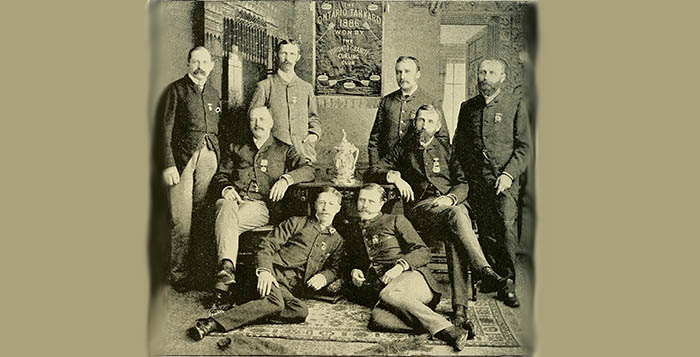This Day in Hockey History – February 16, 1888 – Toronto’s Past and Future
(Photo: Toronto Granite Curling Club, 1885, via Wikimedia Commons)
Competitive hockey in Toronto dates back to February 16, 1888, when two curling clubs paired up to play a different sport. Interest in hockey exploded so that by 1911, the Toronto Hockey Club (Toronto Blueshirts) had a franchise in the National Hockey Association (NHA). In 1917, to bypass difficulties with that club’s owner, the NHA disbanded and reformed as the NHL. The NHL still wanted a Toronto franchise, and the team eventually became known as the Toronto Arenas. The team went through two name (and color) changes before finally, in February 1927, becoming the Toronto Maple Leafs.
In early 1888, the Toronto Globe announced, “During this past week, two teams have been organized to introduce to the Toronto public this fine sport [hockey]. The Caledonia rink team practice in the Caledonia rink on Mutual St. and the Granites in the Granite rink on Church St.” Each of these teams of nine skaters would play two games against each other – one at each rink. For the very first recorded official hockey match in Toronto, they played at Granite rink on February 16, 1888, and the home team won 4-1. The Toronto Globe reported, “The play was very exciting and this sport is sure to become popular.”
The rematch was held at Caledonia rink, and again, the home team won. Arena Gardens was built on the site of the Caledonia rink in 1912. That arena would host the Blueshirts, the Arenas (as of 1917), the St. Patricks (as of 1919), and the Maple Leafs (as of 1927) before becoming a roller-skating rink.
Going into 1927, Toronto’s franchise (the St. Patricks) was struggling financially. Investors like majority owner Charlie Querrie wanted to sell to C.C. Pyle, who wanted to move the team to Philadelphia. Part-owner J.P. Bickell looked to Conn Smythe to be the managing partner. Smythe was supposed to manage a new franchise, the New York Rangers, but he was fired before their first season began. Instead of coaching, Smythe put together a group of investors to buy the franchise. He and Bickell persuaded Querrie to accept the offer for the sake of civic pride. With Smythe investing $10,000, the sale closed on Valentine’s Day. As governor, Smythe made himself the general manager.
Even though it was the middle of the season, Smythe immediately changed the team’s name and later its colors. On February 15, Toronto played its final game as the St. Patricks. They lost 5-1 against Detroit’s franchise. Two days later, on February 17, the Toronto Maple Leafs played their first game. The home team defeated the New York Americans 4-1. Smythe chose the new name for the unofficial national symbol of Canada, and from his World War I service, called it a “badge of courage.” As it happened, since 1896, Toronto had had a baseball team called the Maple Leafs. At first, the sweaters featured a green maple leaf, but starting the next season, they switched back to the blue and white Toronto had originally worn. The blue was supposed to represent the sky, and the white represented snow. The colors also happened to match Smythe’s gravel and sand trucks.
Under Smythe’s leadership, the Maple Leafs won the Stanley Cup eight times. He retired in 1961, just before another Toronto dynasty won four more over the next six seasons. For his role in building the Toronto franchise, Smythe was inducted into the Hockey Hall of Fame in 1958.
Additional Sources:
- https://torontosun.com/2015/02/14/first-hockey-game-in-toronto-history/wcm/fd24b862-c6d5-4694-8388-815901b88102
- https://torontosun.com/2017/01/07/torontos-hockey-history-aint-what-some-say-it-is/wcm/1b09bf6e-bf62-42ed-bcc0-d5b6d22efea0
- https://www.nhl.com/mapleleafs/info/stpatshistory
- https://en.wikipedia.org/wiki/History_of_the_Toronto_Maple_Leafs
- https://www.hhof.com/LegendsOfHockey/jsp/LegendsMember.jsp?mem=b195806&type=Builder&page=bio&list=ByName
- https://www.nhl.com/mapleleafs/news/history-of-the-blue-and-white-rooted-in-green/c-874094
- https://www.hockey-reference.com/teams/TOR/1927_games.html
- https://www.hockey-reference.com/teams/TOR/index.html














